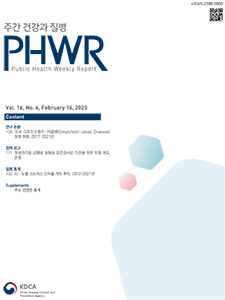Current Issue
Vol.16 No.6, February 16, 2023
-
Original Articles 2023-02-16
 0
0
 1361
1361
 725
725
Current Status of Creutzfeldt–Jakob Disease in the Republic of Korea, 2017–2021
In Sook Shin, Ho Seon Lee, Jeong Ran Kwon, Ji Yeon Lee, Hyang Seon Kim, Kyung Won Hwang*
Public Health Weekly Report 2023; 16(6): 155-170 https://doi.org/10.56786/PHWR.2023.16.6.1 Abstract
AbstractCreutzfeldt–Jakob disease (CJD) is transmitted by pathogenic substances called prions and can rapidly lead to death. However, no specialized treatment (medicine) has been developed to date. The route of infection is classified into sporadic (sCJD), iatrogenic, genetic forms ( gCJD), and variant (vCJD). sCJD accounts for 85–90%, while gCJD accounts for 10–15%. CJD was managed through infectious disease surveillance based on the Infectious Disease Prevention and Control Act. In 2011, the monitoring method was changed to a total surveillance system. From 2017 to 2021, 276 patients had probable CJD in the Republic of Korea. Of the total cases, CJD was diagnosed in 35%, and the incidence was higher in patients aged 60–70 years. Of 276 patients, 150 were women (54.3%) and 126 were men (45.7%), with more women than men by 8.6%. For sCJD, the incidence was 92.6% higher in those aged ≥50 years than that in those <50 years old, and for gCJD, the incidence was 54.2% higher in those aged ≥50 years. Upon analysis of the incidence of cases by CJD type and age groups above 50 and under, a significant difference (p<0.05) was observed. From 2017 to 2021, the incidence of CJD by type was 87.0% for sCJD and 13.0% for gCJD, with an incidence of 0.1 per 100,000 people. There was no domestic occurrence of vCJD.
-
Policy Notes 2023-02-16
 0
0
 2072
2072
 445
445
Operation of the Certification System of the KDCA to Prepare Standard Testing Methods for Infectious Disease Laboratories
Su jeong Ahn, Hyun Yeong Kim, Min Joon Kim, Jae Sun Park, Gab Jung Kim*
Public Health Weekly Report 2023; 16(6): 171-181 https://doi.org/10.56786/PHWR.2023.16.6.2 Abstract
AbstractThe Korea Disease Control and Prevention Agency (KDCA) is responsible for conducting and analyzing rapid and accurate diagnostic tests, and monitoring of pathogens that cause infectious diseases. We are developing a Standard Operating Procedure (SOP) that documents the specifications of the laboratory testing environment, and that outlines a certification system for preparing standard test methods. Based on scientific evidence, the SOP describes the background of test selection, sample types, procedures, and results interpretation. An objectively valid and reliable standard inspection method is being prepared through a certification examination committee composed of internal and external experts. The KDCA will continue to revise and update existing certified standard procedures. In addition, we will act preemptively to prepare for and respond to national crises caused by emerging infectious diseases in the future.
-
QuickStats 2023-02-16
 0
0
 1392
1392
 236
236
Trends in the Prevalence Gap in Perceived Stress Between Cities or Provinces, During 2012–2021
Public Health Weekly Report 2023; 16(6): 182-183 https://doi.org/10.56786/PHWR.2023.16.6.3

pp. 1433~1461
Most Keyword
?
What is Most Keyword?
- It is the most frequently used keyword in articles in this journal for the past two years.
Most Read
-
Waterborne and Foodborne Disease Outbreaks in the Republic of Korea, 2023
Myung-Jae Hwang, So Yeon Park, Hyungjun Kim, Se Jeong Yang, Sungchan Yang, Jin Seon Yang
Public Health Weekly Report 2025;18: 17-32 https://doi.org/10.56786/PHWR.2025.18.1.2 -
Implementation Plan for the Coronavirus Disease 2019 Vaccination for the 2024–2025 Season: Recommendations of the 6th Expert Committee on Immunization Practices
Hyewook Hwang, Wookeon Lee, Seohyeon Ahn, Young-Sook Choi, Seunghyun Lewis Kwon, Dongwoo Lee, Eun Hwa Choi, SokGoo Lee
Public Health Weekly Report 2025;18: 90-102 https://doi.org/10.56786/PHWR.2025.18.2.3
Editorial Office
+82-43-719-7569





 Full Text
Full Text Cite
Cite


